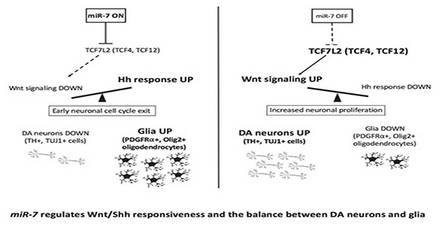
NEW PUBLICATION about the role of the micro-RNA miR-7 in regulating the dopaminergic neurons, the cells primarily affected in Parkinson’s disease
Pubblicato il: 20.03.2020 09:52
Published: 13 March 2020
Title: miR-7 Controls the Dopaminergic/Oligodendroglial Fate through Wnt/beta-catenin Signaling Regulation
Link: www.mdpi.com/2073-4409/9/3/711/htm
We are happy to announce that the journal Cells has just published a study in which, by modulating a microRNA, miR-7, researchers could simultaneously regulate two cell communication pathways, Wnt and Shh, ending up by controlling the formation of dopaminergic neurons, the cell type primarily affected in Parkinson's disease.
The study was carried out on human cells in vitro, and confirmed in vivo, in real time, by observing the formation of dopaminergic neurons in zebrafish (Danio rerio) embryos, thanks to the transparency of this amazing model organism.
The study describes an original control mechanism in the formation of dopaminergic neurons, based on the modulation of a small molecule of RNA, miR-7, functional from fish to humans, opening new perspectives in the field of targeted therapy in Parkinson's disease.
The research involved three centers: the Paduan group of Profs. Natascia Tiso and Francesco Argenton (supported by Telethon, AIRC and AFM-Telethon France), the Singapore group of Prof. Bing Lim, and the Warsaw group of Prof. Vladimir Korzh. The research in Padua was carried out at the DiBio Zebrafish Facility, a center established with the support of UniPD, CARIPARO and EU, and entailed the collaboration of Dr. Giorgia Beffagna and Prof. Stefano Campanaro. The first author of the work, together with Dr. Lavanya Adusumilli, is Dr. Nicola Facchinello, an Umberto Veronesi Foundation fellow.
Nicola Facchinello obtained is PhD in Biotechnology at the University of Padua. During his scientific career, he applied fish and mouse models to analyze a wide range of mechanisms acting during neural, cardiovascular, muscular and endocrine development. These studies entailed the use of genome engineering in the zebrafish, a great model for vertebrate biology and human disease modelling. Dr. Facchinello’s expertise allowed to combine the CRISPR-Cas9 technology with pathway-responsive zebrafish lines and imaging techniques for the detailed visualization of developmental and physio-pathological processes. The final goal of this research is the identification of suitable molecular targets for new therapeutic approaches.





